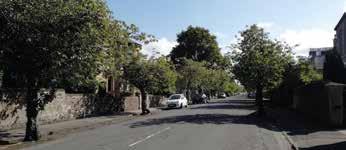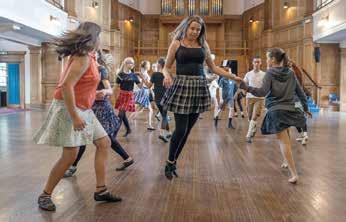
9 minute read
The First Five Years 1923-28
Photo: Ayr, the first home of the Scottish Country Dance Society
In the last issue we reported on the Inaugural Meeting of the SCDS, but what happened next? Jimmie Hill uncovers more details of the early development of the Society.
First press reports
The only newspaper to report our Inaugural Meeting was the Aberdeen Press and Journal. A year later the St Andrews Society of Edinburgh ‘noted with satisfaction that the movement initiated by Mrs Stewart of Fasnacloich for the revival of Scottish country dances had made great progress’. They hoped that ‘Scottish country dances would now be taught in the schools’.
The first meetings
By 1928 we had 10 branches and 1500 members. The early Executive Committee had got down to business with a vengeance! At its first meeting it was agreed Francis Bissett would draft the Constitution; Mrs Stewart would be responsible for recruiting members; and a book of 12 dances would be published. Three committees were set up: a Research Committee, whose two most significant members were Mrs Stewart herself and Lady Dorothea Ruggles-Brise, eldest daughter of the Duke of Atholl and a lifelong music collector; a Publications Committee, made up of Messrs Stewart, Milligan and Diack; and a Dancing Committee, whose immediate aim was to get classes up and running in different areas of Scotland. Book 1 was published a month later. By the end of February 1924 we had 155 members, each paying an annual subscription of five shillings, and it remained the same until 1967. By June membership numbers had doubled to 350 and there had been Scottish country dance sections in the Edinburgh, Glasgow, Perth and Stirling Music Festivals. There is some hint of Edinburgh/ Glasgow competition at the June meeting when it was reported that the standard at the Glasgow Festival had been very high, but in Edinburgh it had ‘not proved satisfactory’. This was crossed out in the minutes and replaced with a comment to the effect that the Edinburgh dancers had not made so much progress because ‘they were waiting for the publication of a definite standard.’ This resulted in Mr Diack’s proposal for a Teachers’ Certificate. They decided there and then to have a teachers’ examination in three months’ time with Mr Diack, Miss Milligan and Mrs Stewart as the examiners ‘with power to issue certificates’. 37 candidates sat the exam with only one failing. The early examinations were based on each individual book, very different from today. Following that first examination, they decided that teachers should be paid ten shillings and sixpence per hour – twice the annual subscription. How many teachers are paid £40 per hour today?
Quarterly meetings
Executive meetings took place quarterly, initially chaired by Francis Bissett, but more often by Lord James Stewart Murray. They were held in Mr Bisset’s office in Glasgow, or in Edinburgh at 12 Melville Street, not far from Coates Crescent. Unlike our present-day Board our early founders dealt with nothing except dancing, teaching, examining, music and books. The agreement on the constitution appears to have gone through easily. Each branch could send one member to the Executive. Six more members were elected at the AGM. This number did not change even into the 1990s Lord James Stewart Murray when there were hundreds of branches.
The first branches
As today the Society was dependent on its branches to recruit and teach. Glasgow and Edinburgh were the first, followed in 1925 by Perth, Dundee and Aberdeen, then Renfrewshire, Stirlingshire, West Dunbartonshire, Clackmannanshire and Moray – ten in five years. Miss Milligan and Mrs Stewart were very important in this. Miss Milligan taught the first Glasgow class of 60 out of which the branch was formed. Edinburgh followed soon afterwards. The Scotsman reported the inaugural meeting of Aberdeen Branch in 1925 in which the Bishop of Aberdeen and Orkney told the meeting that ‘our country dances had behind them that intangible, indefinable, yet living force of national sentiment and patriotism.’ He exhorted the new branch ‘to see that these dances were taught to all the young people in the schools’. Later that year Charles Murray, one of our finest Scots-language poets, was honoured on his retirement. During his speech he said he was ‘glad to observe that a Society had been formed in Aberdeen for the purpose of promoting the old country dances’. He wished it all success.
The books
Unlike today, our first books were not published by us but by Patersons. They printed them, stocked them, advertised them, sold them and distributed them. Each member received a free copy, paid for by the Society at a 40% reduction of the published price. On all other copies sold, the Society received a generous royalty. This meant we had no capital outlay and no risk. Regrettably, we have very little information about how the dances and tunes were chosen. Miss Milligan tells of dancing while Mrs Stewart played the chanter, then she would play the piano while Mrs Stewart danced. It appears the two ladies made most of the decisions between them. By 1926 all three committees had been rolled into one, made up of Messrs Milligan, Stewart and Diack! By the AGM of 1928 four books had been published with Book 5 ready for publication. One book which few today are aware of is the Festival Booklet. This was written by Miss Milligan, edited by Mr Diack and published by Patersons in a series aimed at teachers for festivals. It is a small booklet giving advice to dancers and teachers on steps, formations and dance style, a very early Manual. Michael Diack was instrumental in organising the recording of the tunes for Books 1, 2 and 3 on gramophone records on the Beltona label.
The importance of Music Festivals
At the Inaugural Meeting the importance of teaching children was recognised. Reach the children and you have reached teachers, parents, aunts and uncles, and neighbours. Mr Diack’s involvement with the festivals convinced him of the need to train teachers and set standards. In October 1925 he proposed a two or three-day conference for teachers. In the 1920s the annual Music Festival was a major event in nearly all large towns in Scotland. They were reported locally and the larger ones such as Glasgow and Aberdeen were reported nationally. Enter Miss Milligan, the consummate publicist! All adjudicators must address the audience and she used these opportunities to great advantage. She had a captive audience and could be relied on for a good quote. After the Perth Festival in 1926 The Scotsman reported her saying that the children learn from these dances ‘courage, resolution and spirit, and at the same time personal control.’ At Aberdeen in 1928, the Press and Journal reported, ‘Jean Milligan was enthusiastic as usual. She is adept in the gentle art of mixing praise and blame and no judge could have been more exhaustive or helpful in comment, encouraging in tone.’ In Dundee in 1928 she told the audience that there was a popular misconception that country dances were for the lower classes and are ‘rough’. She said the best example of country dancing was The Flowers of Edinburgh where the partners chase each other and she added, ‘the fun is endless’. In 1928 the Sunday Post reported that ‘Jean Milligan made the surprising intimation that in Scottish Folk Dancing she did not approve of kilts being worn.’ The following day the Dundee Courier continued this debate by reporting her as saying that it was the SCDS itself which had decided this. She maintained that ‘when little girls get into kilts they begin to do step dancing. Could they think of their mothers or grandmothers raising their knees high and exaggerating their steps?’ In all her comments at the festivals it is clear that Miss Milligan wanted to see dancers enjoying themselves and interacting socially. ‘Happy faces mean light feet’, is typical of her. Her comments on one team at Perth in 1927 were, ‘steps nicely carried out, but lacked gaiety’. She said she did not want to see ‘beautiful demonstration dancing’. Earlier in 1928 the Arbroath Herald reported her saying, ‘spirit is the whole point of the dance and spirit does not come from speed.’ Miss Milligan used every opportunity afforded by the festivals to promote the benefits of country dancing. In Aberdeen in May 1926 the Press and Journal reports her telling the audience not to ‘waste their time in other dances’. One wonders if she did not also raise a few hackles.
A hobby for girls and women
From the outset Mrs Stewart had involved the Girl Guide movement. As early as April 1924 the GGs included country dance teaching at a weekend training course. The Women’s Rural Institutes (WRI) took it up quickly and asked for classes in all their branches. At the 1926 Perth Festival Jean Milligan announced, ‘the girls just leaving school are the people we are trying to get hold of’ and in Aberdeen the same year she told the audience, ‘I am sorry to say that I have not seen any boys dancing in Aberdeen!’ The following year she commended the growth of country dancing in the WRI as many girls joined them when too old for the Guides. Reports of country dancing often appeared in the women’s sections of the papers. This, unfortunately, says something about the public’s perception of country dancing.

Park Circus today - elegant and leafy
Staff and premises
The early Society was a modern treasurer’s dream – no staff and no premises! During this period Mrs Stewart ran the Society from her home at 3 Park Circus, Ayr. In a later letter she confirmed that she had had the idea for the Society while walking along Princes Street in Edinburgh. It was then born in Glasgow but she was to write in 1961 that Ayr was its ‘cradle’. It was not until membership passed the 1000 mark that the need for a paid assistant was clear. Miss Winifred Forgan of Ayr was employed part-time in 1928 at a salary of £3 per month.
Finance
With few overheads, the Society was funded out of members’ subscriptions. Branches, on the other hand, did not have the system we have today of a local membership fee. In the first few years branches applied to the Society for small grants to cover their expenses – typically five or ten pounds and usually repaid. In 1926 it was decided that 5% of the annual subscription should be given back to branches, raised to 10% from 1928. Events were budgeted to break even. The first Summer School in 1927 made a loss of just under £5 while a year later it made a profit of over £7. Teachers’ fees made up over 10% of the Summer School budget. By the AGM of 1928 the Society had £400 cash in the bank, c.£20,000 in today’s money.
Finally
The main impressions we get from those early years are the hard work and connections of Mrs Stewart, the indefatigable enthusiasm of Jean Milligan, and the commitment of busy people such as Francis Bisset, Michael Diack, Miss Ross, Miss Dalmahoy, and Lord James Stewart Murray. With hindsight, what they were doing was attempting to build a Scottish cultural identity after the huge loss of life in WW1 followed by the flu epidemic of 1918-19, which, worldwide, killed even more people than the war itself. What they constantly state as their aim is to introduce traditional Scottish country dances into the repertoire of the mainstream ballroom. In that aim they failed. What they started, however, formed the basis for the RSCDS of today.
I am grateful to Alan Macpherson, Society Archivist, for his patience in answering all my questions and to the National Library of Scotland and Edinburgh City Library.










